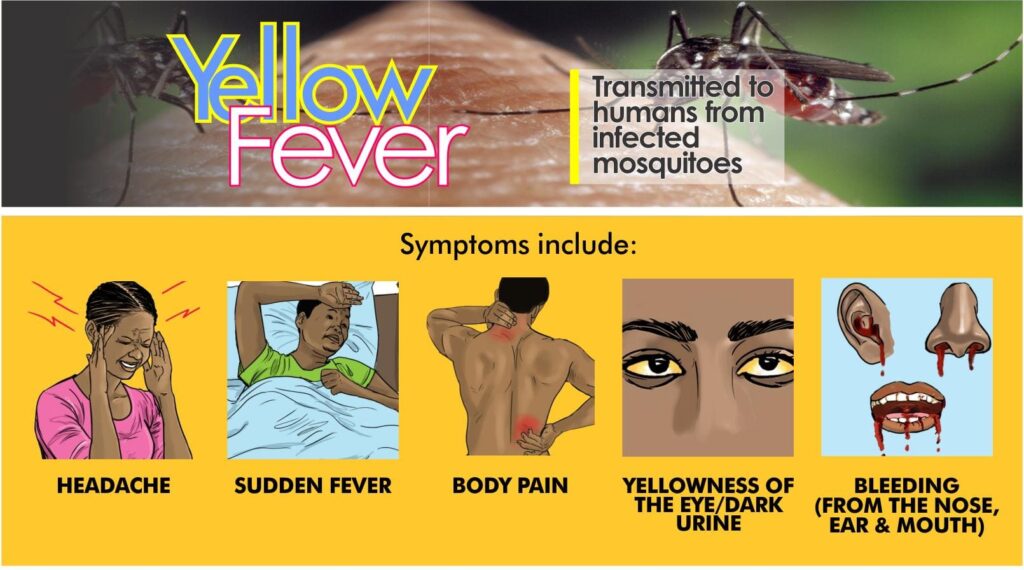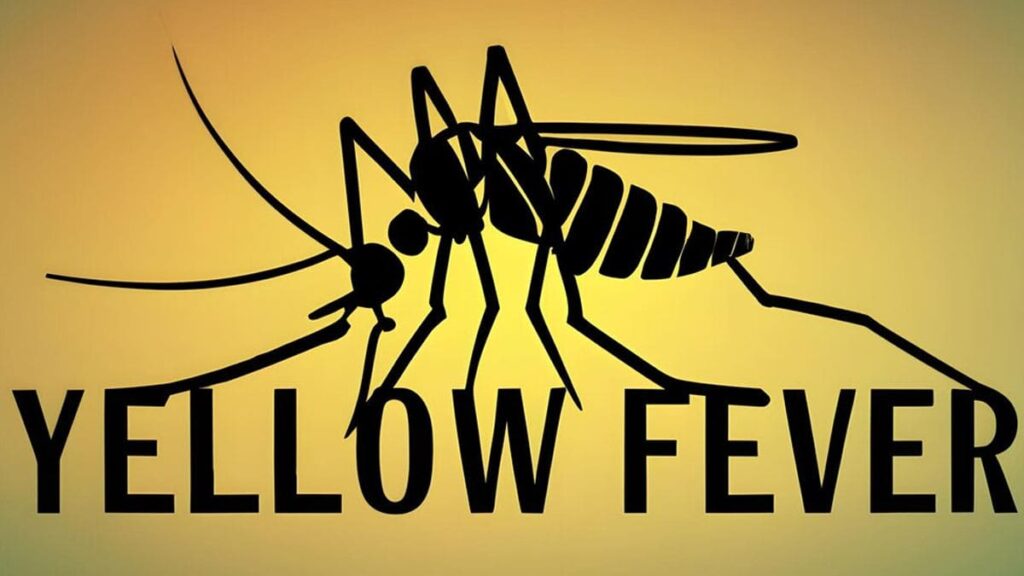Table of Contents
ToggleYELLOW FEVER
Yellow fever is an acute viral hemorrhagic disease transmitted by infected mosquitoes.
Yellow fever is an acute, contagious, notifiable viral hemorrhagic fever endemic in central and South America and Africa.
The name derives from the jaundice (yellowing of the skin and eyes) that affects some patients.
Aetiology:
Yellow fever is caused by the yellow fever virus (YFV), an arbovirus belonging to the Flavivirus genus of the Flaviviridae family. The virus is approximately 25-65 nm in size and can survive at 40°C for a month and in a freeze-dried state for many years.
Forms and Routes of Transmission:
The primary mode of transmission is through the bite of infected Aedes mosquitoes (primarily Aedes aegypti in urban areas and Aedes africanus in sylvatic/jungle cycles). These mosquitoes become infected when they feed on the blood of infected primates (monkeys, apes) or humans.
There are two main transmission cycles:
- Sylvatic (Jungle) Cycle: This cycle involves transmission between monkeys and mosquitoes in forested areas. Humans can become infected through contact with this sylvatic cycle if they venture into these areas.
- Urban Cycle: This cycle occurs in urban areas where Aedes aegypti mosquitoes are abundant and feed on both infected humans and other humans. This cycle is responsible for larger outbreaks.
Incubation Period:
The incubation period for yellow fever is typically 3 to 6 days, but can range from 2 to 15 days. This is the time between the bite of an infected mosquito and the onset of symptoms.
Pathology:
After entering the body through a mosquito bite, the virus multiplies in lymph nodes and organs (liver, kidneys, heart, lungs, spleen, brain, digestive tract). The virus primarily affects specialized epithelial or myocardial cells. Cellular changes range from cloudy swelling to generalized fatty changes, coagulation, and necrosis.
- Liver: Destruction of epithelial cells in liver lobes.
- Kidneys: Necrosis of tubular epithelium.
- GIT: Hemorrhage due to damage of blood vessels.
Death can result from liver or kidney failure (or both). Damage to the sino-atrial node, bundle of His, and myocardial cells can also contribute.

Clinical Features
Yellow fever presents in two phases:
Phase 1 (Acute Phase): This phase usually lasts 3-4 days and includes:
- Sudden onset of fever (often high, 38.3°C to 40°C or higher)
- Severe headache
- Muscle aches (particularly back pain)
- Shivering
- Nausea and vomiting
- Loss of appetite
- Fatigue
- Malaise
Phase 2 (Toxic Phase): This phase doesn’t always occur and only develops in severe cases. It’s characterized by:
- Jaundice (yellowing of the skin and whites of the eyes)
- Bleeding (from the nose, mouth, or gums – hemorrhage)
- Abdominal pain
- Dark urine
- Low blood pressure (hypotension)
- Impaired kidney function
- Delirium
- Shock
- Seizures
A short period of recovery may occur, followed by a return of fever and rapid deterioration with liver and kidney failure.
- Continuous abdominal pain with vomiting of altered blood (“coffee ground” or fresh blood) or black vomit (melena), and potentially diarrhoea.
- Bleeding from eyes, nose, mouth, bladder, rectum, and other organs.
- Heavy proteinuria (protein in the urine) with oliguria (decreased urine output) and granular casts, red blood cells (RBCs), and haemoglobin (Hb) in the urine.
- Death occurs with increasing proteinuria, haemorrhage, rising pulse, hypotension, and oliguria.
Diagnosis and Investigations:
Diagnosis is based on:
- Clinical presentation: Symptoms are highly suggestive.
- Serological tests: Detection of IgM antibodies in the blood using ELISA (enzyme-linked immunosorbent assay) or other methods indicates recent infection. LFT’s and RFT’s
- Virus isolation: This can be performed from blood samples during the acute phase of illness, but is less commonly used due to the availability of serological testing.
- PCR (Polymerase Chain Reaction): Detection of viral RNA in blood samples. This is a more sensitive technique for confirming diagnosis.
Management:
Aims:
The primary aims of management are:
- To provide supportive care to manage symptoms.
- To prevent complications.
- To reduce mortality.
Medical Management:
No specific antiviral treatment is available for yellow fever. Management focuses on supportive care, including:
- Fluid and electrolyte balance: Careful monitoring and replacement are crucial.
- Respiratory support: Oxygen therapy as needed.
- Blood pressure management: Vasopressors if needed.
- Seizure control: Anticonvulsants as needed.
- Monitoring for organ dysfunction: Close monitoring of kidney function, liver function and other organ systems is critical.
- Nutritional support: Enteral or parenteral nutrition as necessary.
Nursing Care:
Nursing care is essential and focuses on:
- Monitoring vital signs: Frequent monitoring of temperature, heart rate, blood pressure, respiratory rate, and oxygen saturation.
- Fluid balance management: Careful monitoring of fluid intake and output.
- Neurological assessment: Regular neurological checks for signs of encephalopathy.
- Skin assessment: Monitoring for jaundice and signs of bleeding.
- Hygiene: Maintaining personal hygiene to prevent skin breakdown.
- Pain management: Providing analgesics as needed.
- Emotional support: Providing emotional support to the patient and their family.
Prevention:
- Vaccination: The most effective preventive measure is vaccination. A single dose of the yellow fever vaccine provides lifelong protection.
- Mosquito Control: Reducing mosquito breeding sites through eliminating standing water, using insecticides and using mosquito nets.
- Personal Protective Measures: Wearing protective clothing (long sleeves, long pants) and using insect repellent containing DEET or other EPA-approved repellents when in endemic areas.
Complications:
- Hepatitis: Liver inflammation can lead to liver failure.
- Renal failure: Kidney damage can result in acute kidney injury or failure.
- Encephalitis: Brain inflammation can lead to neurological deficits.
- Myocarditis: Heart muscle inflammation.
- Hemorrhagic manifestations: Severe bleeding can be life threatening.
- Shock: This can be fatal if not promptly managed.
- Death: Yellow fever can be fatal in a significant proportion of severe cases.

